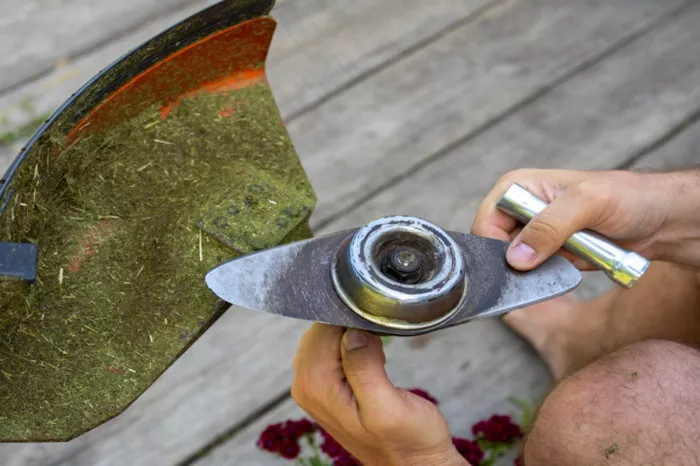When it comes to maintaining a healthy and well-manicured lawn, the lawnmower plays a pivotal role. However, an often-overlooked component of this essential garden tool is the blade. A common question among homeowners and gardening enthusiasts is: Are lawnmower blades universal? Understanding the compatibility and types of lawnmower blades is crucial for optimal performance and safety.
Are Lawnmower Blades Universal?
The Short Answer: No
Lawnmower blades are not universally compatible across all mower models. While some blades are designed to fit multiple models, several factors prevent a one-size-fits-all approach.
Factors Affecting Compatibility
Blade Length and Width: Different mowers require blades of specific lengths and widths to ensure proper cutting and balance.
Lowe’s
Mounting Hole Design: Blades attach to the mower via a central hole, which can vary in shape—such as round, 5-point star, 6-point star, or bow-tie. Using a blade with an incompatible mounting hole can lead to improper installation and potential hazards.
Lowe’s
Blade Thickness and Curvature: The thickness and curvature of a blade affect its cutting efficiency and compatibility with the mower’s deck design.
Rotation Direction: Some mowers have blades that rotate clockwise, while others rotate counterclockwise. Installing a blade with the wrong rotation direction can damage the mower and result in poor cutting performance.
Universal Blades: A Cautionary Note
While some manufacturers offer “universal” blades equipped with multiple mounting holes or adapter kits, these are not always the best choice. Such blades may not fit as securely as model-specific ones, leading to vibrations, uneven cuts, or even safety risks. It’s advisable to use blades specifically designed for your mower model.
Types of Lawnmower Blades
Understanding the different types of lawnmower blades can help you choose the right one for your mowing needs.
1. Standard Lift Blades
Also known as medium-lift blades, these are the most common type found on rotary mowers. They provide a balance between lifting the grass for a clean cut and discharging the clippings efficiently.
2. Low-Lift Blades
Designed with a slight curvature, low-lift blades generate less suction, making them ideal for mowing in sandy or dusty conditions. They reduce the amount of dust and debris kicked up during mowing.
3. High-Lift Blades
High-lift blades have a more pronounced angle, creating greater airflow to lift the grass upright before cutting. This design is particularly effective for bagging clippings and mowing tall or dense grass.
4. Mulching Blades
Also known as 3-in-1 blades, mulching blades have a curved design with extra cutting edges. They cut the grass into finer pieces, allowing the clippings to decompose quickly and return nutrients to the soil.
5. Gator Blades
Gator blades are a type of mulching blade with serrated edges, enhancing their ability to shred grass and leaves into very fine particles. They are excellent for mulching and handling tough mowing conditions.
6. Specialty Blades
These include blades designed for specific tasks, such as dethatching or mowing particular grass types. They are less common but can be highly effective for specialized lawn care needs.
Bobby Ford Tractor & Equipment
How to Choose the Right Blade
Selecting the appropriate blade for your lawnmower involves several considerations:
Consult the Mower Manual: The owner’s manual provides specifications for compatible blade types, sizes, and part numbers.
Check the Existing Blade: Look for part numbers or manufacturer markings on your current blade to find an exact replacement.
Measure the Blade: If the part number is unavailable, measure the blade’s length, width, thickness, and center hole diameter to find a compatible match.
Consider Mowing Conditions: Choose a blade type that suits your lawn’s conditions—opt for high-lift blades for bagging, mulching blades for nutrient recycling, or low-lift blades for sandy soils.
Avoid Universal Blades: Unless specifically recommended by the manufacturer, steer clear of universal blades to ensure safety and optimal performance.
Installation & Maintenance
Proper installation and regular maintenance of your lawnmower blade are essential for safety and efficiency.
Installation Tips
Ensure Proper Fit: The blade should fit snugly onto the mower’s spindle without excessive play.
Use Correct Hardware: Always use the appropriate bolts and washers as specified by the manufacturer.
Torque Specifications: Tighten the blade bolt to the manufacturer’s recommended torque to prevent loosening during operation.
Maintenance Guidelines
Regular Sharpening: Sharpen the blade regularly to maintain a clean cut and reduce strain on the mower.
Inspect for Damage: Check the blade for nicks, bends, or cracks before each use. Replace damaged blades immediately.
Replacement Interval: Depending on usage, replace the blade every 1–3 years to ensure optimal performance.
Conclusion
While the idea of a universal lawnmower blade is appealing, the reality is that blades are not universally compatible due to variations in size, mounting design, and mower specifications. To ensure safety, efficiency, and the health of your lawn, it’s crucial to select a blade that matches your mower’s requirements and your specific mowing conditions. Always refer to your mower’s manual, and when in doubt, consult with a professional to find the right blade for your needs.
Related topics:
- How to Use Flymo Lawn Mower?
- How Much Oil Does A Craftsman M110 Lawn Mower Take?
- How Much Is a Gtech Cordless Lawnmower?

